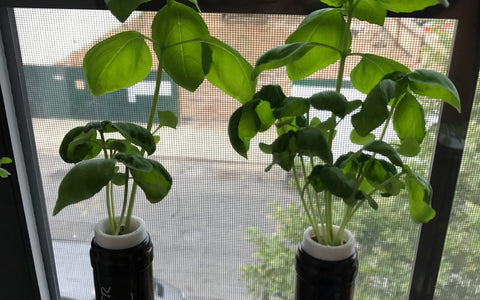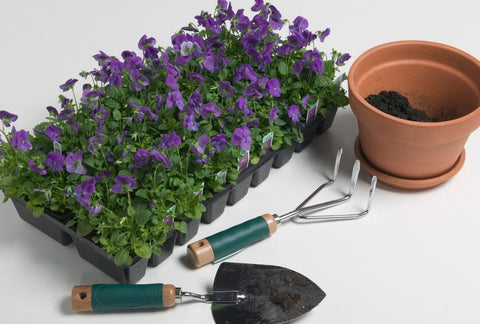Although The World’s Smallest Garden is one of the easiest beginner gardening products out there, the reality is that when we’re dealing with living organisms like plants, sometimes things don’t go quite as planned.
This guide covers some common symptoms you may encounter (what), their likely cause (why), and the steps you can take to address them (how).
The most important thing is that if at first you don’t succeed, try again! With a little bit of patience, we’ll make a Plant Mama (or Papa) out of you eventually.
What: My plant sprouted then died
Why: The conditions were good for your plant to germinate, but something went wrong as it tried to grow larger. This is most commonly due to a cold snap or insufficient light. Cold temperatures, especially if your window is single-pane or cracked open, can shock your sprouts and cause them to die back. If there isn’t enough light for the older plant to grow, the seedling will grow up tall and skinny as it puts all its energy into growing vertically in search of more light.

A “leggy” basil plant looking for more light (left) and some seedlings shocked by a cold snap (right)
How to fix it: The good news is that all of the nutrients will still be in the bottle (don’t change the water) and you should still have plenty of seeds to give it another shot! If you think a cold snap took out your plant, start over when the temperatures are a little warmer or place it in a more protected spot. If your plant wasn’t getting enough light, you will have to move it to a sunnier spot or invest in a grow light.
What: Plant flops over and doesn’t stand up by itself
Why: Your plant has a weak stem. Your plant’s growth outpaced the ability of the stem to support it and is a little floppy.

Top-heavy Basil Plant with bamboo support attached with a twist tie
How to fix it: This is a very easy fix! Just place a support (we like bamboo skewers) to help the plant stay vertical while it bulks up its stem base. If you are planning on moving your plant around, you can use a twist-tie to fix the stem to the skewer for additional support.
What: There’s fuzzy stuff growing on the surface
Why: You’ve created an environment conducive to life and organic growth, and now you are seeing some naturally occurring fungi. Fungi can be “good” or “bad,” but our smart soil is loaded with beneficial fungi (Trichoderma, Penicillium, and Mocor), so although it might look a little funky, chances are it’s doing no damage at all. It may, in fact, even be improving the health of your plant.

“Good” fungi, helping the roots absorb nutrients (left) and “Bad” Fungi, consuming seeds before they sprout (right)
How to fix it: A little bit of fungi is nothing to be alarmed at, but if it does start to overtake the entire surface of your garden, increasing the airflow is the best way to keep it under control. If fungi are growing after your plant sprouted, remove the germination sticker and place the bottle near a fan or breezier area. If your seeds never sprout (but fungi do), then scrape the fungi off the surface and try planting some more seeds—this time without the germination sticker—to allow for better airflow.
What: There’s algae growing in the bottle
Why: The color of the bottle you used did not block out the kinds of light that allow for algal growth. Algae are now consuming the nutrients meant for your plant!

Algae Growth in Clear Bottles
How to fix it: If you see algae starting to grow, you can transfer the nutrient solution and plant to another bottle or add a covering that will block out the light. We have seen people use tin foil, paper bags, or even paint their bottles.

Wrapped, Decorated, and Dark Bottles
What: My plant is growing really slowly
Why: All plants grow at different rates—some are faster (e.g., basil) than others (e.g., mint). Regardless of the variety, they don’t need much light when they’re young, but as they get older, growth will be proportional to the amount of light they receive. Check out our lighting blog to learn more.
If plants are not receiving enough light, they will often “reach” for light, causing them to grow long stems while not devoting energy to leafy growth.
How to fix it: This can be remedied by changing the lighting situation. If ample natural lighting is not available, grow lights are a popular option for indoor gardeners of all experience levels.
What: The roots are so thick that it is hard to water
Why: Growing a plant in the neck of a bottle comes with its own challenges—mostly a lack of real estate. When your plant has thick roots, it can be hard to fully remove and reinsert it without doing damage.
How to fix it: There are a couple of things you can do to make watering easier. As a proactive move, you can pick a bottle with a little wiggle room. Once it’s grown, if you lift the garden halfway out and pour water down the side with something like a sport-top bottle, it makes for easy and gentle watering (thanks for the tip, Beth!). In our grow-lab, we use a big plunger ($16) with the tubing placed along the garden. Added benefit is you can track exactly how much water the plant is using!

Using a sport cap bottle (left) or a big syringe (right) to make watering easy
What: My plant’s leaves are turning yellow
Why: There are a few potential reasons for this, but the most likely is that it is running out of nutrients. The World’s Smallest Garden comes with enough nutrients (plant food) to keep herbs alive for 5-6 months, but after that, they’re going to run out of food. The good news is now is the time to harvest your entire plant and enjoy a feast!
If you’d like to reuse the plastic inserts, you can just replace the Smart Soil inside—this is available on our website. In order to ensure a continual supply of fresh herbs and other edible treats, we recommend starting a new set of gardens every 2-3 months.







There are no comments for this article. Be the first one to leave a message!